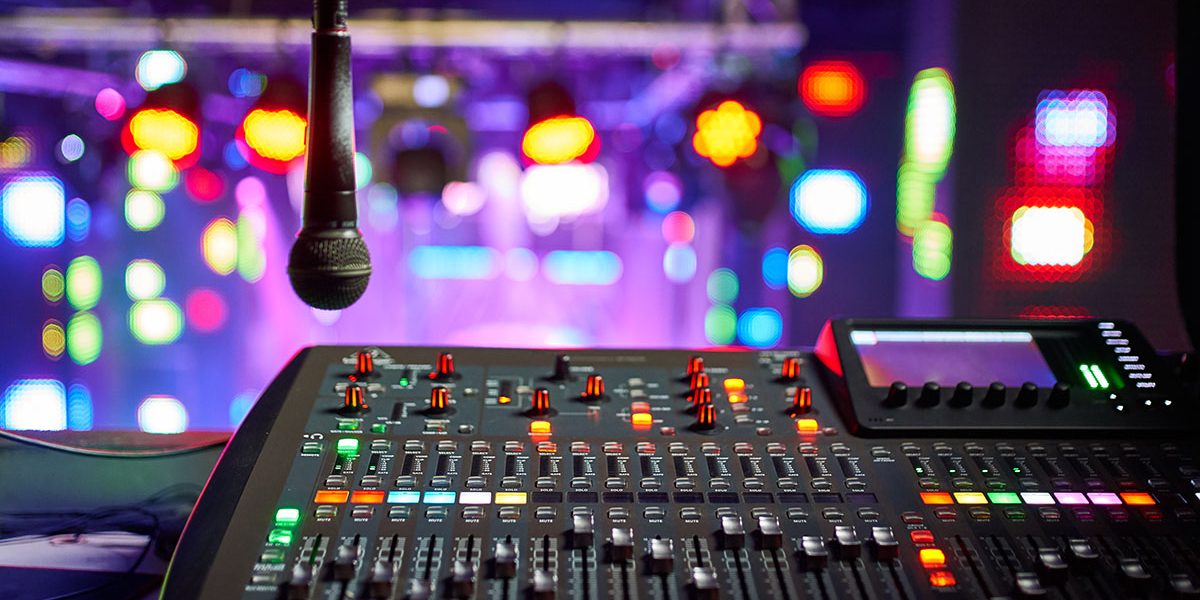How audio visual charlotte nc transforms event branding
Comprehending the Inclusion of Audio Visual Technology in Today's Educational Environments
The assimilation of audio-visual innovation in instructional setups has changed the teaching and finding out process. Educators now have accessibility to tools that accommodate various finding out styles, enhancing pupil involvement and partnership. The consolidation of these modern technologies provides both possibilities and difficulties. Understanding exactly how to properly carry out these tools is necessary. What techniques can instructors utilize to maximize the benefits of audio-visual modern technology in their class?
The Advancement of Audio-Visual Innovation in Education And Learning
As educational demands advanced over the decades, audio-visual innovation undertook substantial changes that improved the discovering setting. Initially, tools such as movie projectors and slide programs were the primary means of integrating aesthetic components right into classrooms. These early modern technologies provided educators with the ability to present info dynamically, yet they were restricted in ease of access and interactivity.
With the development of video clip cassette recorders in the 1970s, class started to integrate documented lessons, widening the scope of educational resources. The introduction of desktop computers in the 1980s more transformed this landscape, enabling the production of multimedia presentations and interactive knowing experiences.
The rise of the internet in the 1990s marked a critical moment, enabling real-time access to a wealth of audio-visual materials. Today, digital tools such as interactive white boards and on-line understanding systems proceed to enhance the educational experience, fostering involvement and cooperation among learners.
Advantages of Audio-Visual Equipment for Diverse Knowing Styles
Audio-visual tools play an important role in providing to diverse learning designs by improving visual understanding and boosting auditory involvement. By integrating images, video clips, and noise, these technologies develop a more comprehensive academic environment. This complex method allows teachers to deal with the diverse preferences and needs of trainees efficiently.
Enhancing Visual Understanding
Interaction in the understanding process is substantially improved via the use of audio-visual devices, satisfying numerous learning designs. These devices, such as videos, infographics, and interactive discussions, provide aesthetic stimulations that help understanding and retention. Visual learners, specifically, take advantage of the consolidation of images and animations, which can streamline intricate ideas and improve understanding. Additionally, audio-visual resources can highlight real-world applications, making finding out more pertinent and engaging. By integrating shade, activity, and sound, educators can produce a vibrant learning atmosphere that catches pupils' attention and promotes much deeper cognitive links. Inevitably, the tactical usage of audio-visual modern technology not just supports visual discovering yet likewise improves the overall educational experience for diverse students.
Improving Auditory Interaction
A considerable benefit of including audio-visual devices in education and learning is their ability to enhance auditory interaction among pupils. These devices, which encompass multimedia presentations, podcasts, and interactive sound elements, satisfy various discovering styles, especially profiting acoustic students (audio visual charlotte nc). By incorporating audio and narrative, teachers can produce immersive experiences that catch trainees' interest and strengthen comprehension. This engagement is necessary, as it promotes a deeper understanding of the material and promotes retention. Additionally, audio-visual devices can promote joint understanding settings, urging pupils to join conversations and share their insights. Ultimately, the incorporation of audio-visual modern technology not just supports acoustic interaction however also enriches the total academic experience, making finding out more vibrant and efficient for all trainees
Enhancing Engagement Via Interactive Discovering

Gamification components, such as quizzes and simulations, can improve inspiration and retention, making learning a lot more delightful and effective. These techniques not just stimulate cognitive interaction yet also cater to varied understanding styles, making sure that all pupils can participate meaningfully. Because of this, interactive discovering settings foster a sense of neighborhood and belonging, eventually bring about improved academic results. Via the integration of audio visual innovation, instructors can transform standard class into lively rooms where students flourish and actively shape their academic trips.
Connecting Concept and Experiment Multimedia Resources
Multimedia resources act as an important link between academic ideas and sensible application in educational settings. By improving interaction, helping with collaborative knowing experiences, and supporting diverse learning designs, these devices produce a much more inclusive and dynamic knowing environment - audio visual charlotte nc. This approach not just cultivates much deeper understanding however likewise prepares students for real-world challenges

Enhancing Engagement Through Multimedia
Involvement in academic settings greatly raises when teachers integrate multimedia resources right into their mentor strategies. Using videos, podcasts, and interactive presentations boosts the discovering experience, allowing pupils to link with the material on numerous levels. Multimedia sources deal with numerous discovering styles, giving aesthetic, auditory, and kinesthetic stimulations that can hold trainees' interest better than standard lecture approaches. Additionally, these resources can simplify complicated principles, making them more available and memorable. By incorporating multimedia, teachers can create a vibrant classroom atmosphere that fosters interest and encourages learners. Inevitably, the tactical usage of audio-visual technology serves to bridge the void between theoretical expertise and practical application, enhancing the instructional experience for both instructors and trainees.
Facilitating Collaborative Knowing Knowledge
Numerous research studies show that joint knowing experiences substantially enhance trainee end results when integrated web with multimedia resources. Multimedia tools assist in communication amongst students, enabling them to take part in analytic and critical thinking collectively. By using video conferencing, joint platforms, and interactive presentations, educators produce atmospheres for synergy and shared understanding. These modern technologies allow trainees to interact their ideas successfully and obtain prompt responses, cultivating a much deeper understanding of the topic. On top of that, multimedia sources can offer intricate principles in even more digestible styles, promoting discussion and partnership. Because of this, the combination of collaborative knowing and audio-visual technology not only enriches the instructional experience yet additionally prepares pupils for real-world team effort dynamics, highlighting the significance of collaboration and collective knowledge construction.
Sustaining Diverse Understanding Styles
While standard mentor methods frequently cater to a minimal variety of discovering preferences, the assimilation of audio-visual innovation provides a more comprehensive technique to education. By using multimedia sources such as videos, interactive simulations, and digital discussions, instructors can resolve different learning designs, including aesthetic, auditory, and kinesthetic. This flexibility enables distinguished instruction, making it possible for trainees to engage with material in manner ins which reverberate with their private choices. Furthermore, audio-visual devices can assist in much deeper understanding by supplying multiple depictions of complicated principles. As a result, pupils who might deal with conventional approaches can find alternate pathways to success, promoting a more equitable understanding atmosphere that sustains academic success for all learners.
Obstacles in Executing Audio-Visual Modern Technology
Audio-visual innovation holds great guarantee for enhancing academic experiences, its execution often comes across substantial challenges. One primary worry is the economic burden connected with acquiring and keeping such tools, which can stress budgets, particularly in underfunded organizations. Furthermore, insufficient training for instructors can prevent reliable assimilation, leaving them ill-prepared to make use of the technology fully. Technical issues, such as software malfunctions and compatibility problems, may also disrupt lessons and frustrate both teachers and students. Differing degrees of trainee access to innovation outside the classroom can create disparities in finding out possibilities. Ultimately, the possibility for over-reliance on innovation may interfere with important teaching methods, inevitably restricting the instructional experience. Resolving these difficulties needs an extensive approach, consisting of appropriate financing, specialist growth, and fair accessibility to sources, to ensure that audio-visual technology can be leveraged effectively in today's academic settings.
Best Practices for Integrating Innovation in the Classroom

Furthermore, cultivating an interactive setting through collaborative tools encourages student interaction and involvement. Using varied audio-visual sources accommodates numerous finding out designs, accommodating visual, auditory, and kinesthetic learners. On a regular basis reviewing the influence of modern technology on Look At This student understanding helps educators refine their approaches and adjust to transforming demands. Entailing trainees in the choice of technology promotes possession and inspiration. By sticking to these finest practices, educators can develop a vibrant classroom atmosphere that effectively incorporates modern you could try these out technology and improves the educational experience for all students.
The Future of Audio-Visual Modern Technology in Education
As class significantly accept innovation, the landscape of audio-visual tools in education remains to advance (audio visual charlotte nc). Future advancements are expected to concentrate on higher interactivity and personalization, permitting educators to customize discovering experiences to individual trainee needs. Technologies such as enhanced fact (AR) and online reality (VIRTUAL REALITY) will likely provide immersive understanding atmospheres, boosting trainee involvement and understanding
Furthermore, artificial knowledge (AI) is positioned to play a considerable duty in audio-visual technology by supplying real-time feedback and flexible learning paths. This combination may aid educators determine and resolve student difficulties extra efficiently. Cloud-based platforms will certainly facilitate simpler accessibility to sources and collaboration among trainees and educators, regardless of place.
Along with these technical advances, professional advancement for teachers will certainly be essential, ensuring they are geared up to use these devices successfully. On the whole, the future of audio-visual technology in education guarantees to produce even more vibrant, comprehensive, and impactful understanding experiences.
Regularly Asked Questions
How Can Teachers Select the Right Audio-Visual Equipment for Their Class?
Choosing proper audio-visual devices calls for educators to analyze their educational goals, think about trainee requirements, examine offered innovation, and look for suggestions from peers or professionals, making sure devices properly boost learning and involvement within their details classroom environment.
What Budget Considerations Are There for Executing Audio-Visual Technology?
Budget plan considerations for executing audio-visual innovation include preliminary acquisition costs, maintenance costs, training for personnel, and potential software licensing costs. Additionally, long-lasting investment in updates and replacements must likewise be factored right into economic planning.
Are There Certain Training Resources for Educators on Audio-Visual Devices?
Lots of organizations offer training sources for instructors on audio-visual tools, consisting of online training courses, workshops, and training guides. These sources aim to boost teachers' skills and self-confidence in effectively incorporating technology right into their teaching techniques.
Exactly how Do We Gauge the Efficiency of Audio-Visual Technology in Discovering?
Measuring the efficiency of audio-visual technology in discovering entails assessing pupil engagement, understanding, retention rates, and general scholastic performance. Studies, assessments, and observational studies can offer valuable understandings into its influence on academic end results.
What Prevail False Impressions Regarding Audio-Visual Modern Technology in Education?
Typical false impressions regarding audio-visual modern technology in education consist of the idea that it guarantees involvement and discovering outcomes, as well as the presumption that all students benefit similarly, forgeting individual knowing preferences and requirements.